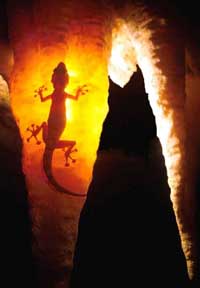 |
© 2005 by John and Susy Pint - Photos by J. Pint unless otherwise credited
Updated September, 2013
...The first room in
the cave had five geckos
on the ceiling, one of which turned out to be an ideal photographers’
model.
We believe it is Ptyodactylus hasselquistii. This gecko was observing
us strange invaders from a wide, thin, translucent stalactite
and stayed there for at least an hour while each of us took turns
photographing
it from every possible angle… and all we had to do was tap it on the
nose or
tail to get it to move up or down. That’s where the name Gecko Cave
came from,
but in Arabic it eventually became known as Kahf Al Rootoobah, which
means
Steamy Cave and is also quite appropriate as you’ll see below.
FAHRENHEIT
120
It
was only late in May of 2002 that we were able to return to Gecko Cave
to map
and photograph its many interesting features. In the month of May,
however, the
temperature soars right up to the highest number reached by most
thermometers
and the success of our mission depended on finding a refuge for our
food,
equipment and drivers while we went about our work.
Our
first choice was Abu Marwah, where we hoped to find shade at the bottom
of its
steep walls. Alas, before we were halfway down the slope we felt we
were
entering a hellhole which was hotter than the surface! Next, we went to
Mossy
Cave, figuring its 24 degrees (76 F) would seem cool on a day like
this. But,
alas again, the high humidity in the air wafting out of the cave was
enough to
steam my glasses and get me dripping wet in two minutes. “Forget it,”
we
said and drove off with no goal in mind, just stopping at every hole we
saw and
reaching out a hand to feel for blessed cool air.
UNDERGROUND HEADQUARTERS
Just
like in the movies, we were saved at the very last moment. Exactly as
sunset was
upon us, we drove up to a very large depression. This hole had a long,
gentle,
sandy slope leading down into a wide, beautifully lit room which looked
welcoming and comfortable. Behind what immediately became our dining
hall, we
found several rooms with flat, sandy floors, 45% humidity and a cool 21
degrees
C (70 F). Some were partially lit, others were in total darkness and
all were
perfect for sleeping.
Checking
coordinates, we discovered we had chosen for our refuge, B31 Cave,
which is only
three kms away from Gecko.
Mahmoud squeezing out of the tortuous entrance passage.
|
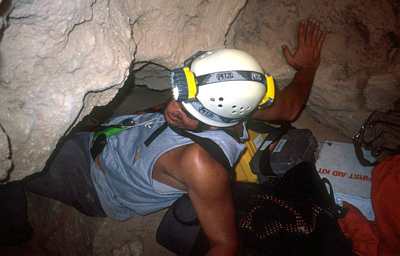 |
IDEAL
FOR DWARVES
Two
special characteristics of Gecko cave are its smooth, soft, sandy floor
and its
rather low roof, forcing you to crawl on hands and knees or at least
walk
bent-over in a Groucho Crouch in order to get anywhere. Unfortunately,
one of
the few places in Gecko cave that doesn’t have a
soft, sandy floor, is
the entrance passage, which is maliciously paved with sharp, broken
rocks and
has a ceiling so low that only a long belly crawl will get you inside.
Of
course, if you happen to have a ton of equipment with you, each piece
must be
pushed or pulled through that same long slot. Now, we not only had to
bring in
our cave packs, survey and photography gear (including tripods and
Coleman
lanterns), but also various other items like GPS, satellite phone,
food, water,
etc. which could not be left sitting in a car which would quickly be
turned into
an oven while we were inside the cave.
...Then we began
mapping,
taking compass readings both forward and back (Every time we have run
into a
problem turning our data into a map, it’s always been due to a bad
compass
reading). Once again, we saved lots of time by using our Disto laser to
take the
measurements up, down, left, right and forward.
This shot proves there is no danger of going hungry in Gecko Cave.
|
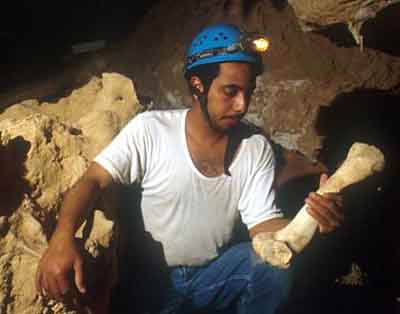 |
Here is just one of many displays of stalactites of many sizes and shapes, some with delicate red bands...
|
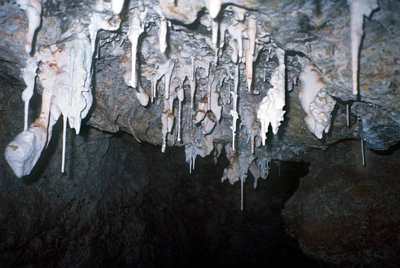 |
| Of
course, surveying forced us to peek into previously overlooked corners
of the
cave and we discovered (a) a place where we could actually stand up (!!) .... |
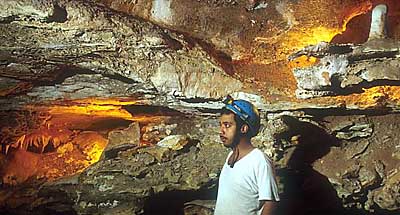 |
| ...
and (b) a room with two ceiling holes which eerily resemble the
tooth-encircled black maws of ferocious sharks. And here we present the sad saga of a doomed caver, fatally obsessed by the mystery of THE GREAT WHITE CAVE SHARK |
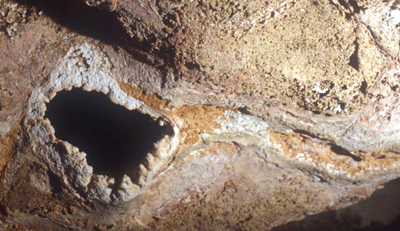 |
STEAMED
IN A TURKISH BATH
| 50 meters into the
cave, you hook a right and head SW. It’s another low belly-crawl
followed by a squeeze into a wide room, stretching off both left and
right...
|
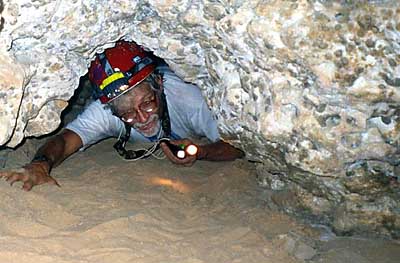 |
...
Here you can see the cave’s most impressive displays of stalactites,
stalagmites, columns and flowstone, but there was something weird about
the
place… in a matter of minutes I lost all my enthusiasm for exploration
and
could barely muster attention for the surveying. Listless, I dragged my
feet
over to a piece of flagging tape that had been hanging in this room for
a year
and a half.
Well,
that flagging tape looked very strange indeed. Down both sides of it
were
sliding numerous drops of water which then dripped off the end to the
floor. We
had created artificial stalactites!
The
hygrometer showed the humidity of this area to be a whopping 97%. It
was a
natural steam bath and I am sure lots of Turkish tourists will
especially enjoy
a visit to Gecko Cave, which Mahmoud decided to call Kahf al Rootoobah
for its
humidity and also, perhaps, because there was nary a gecko to be seen
on either
of the days we worked in the cave.
For
me it was a great relief to leave that sticky zone and crawl back into
the
“normal” part of the cave with its pleasant 66-69% humidity. In fact,
the
next day I was quite content to photograph every other corner of the
cave but
the Steam Bath, with the help of Said, while Mahmoud and Abdulrahman
wrote up a
geological description of the cave, which required their return to this
energy-draining area.
| This is the Coral Room (so named
because it's where those nasty sharks hang out). Here we held some long
photo sessions...
|
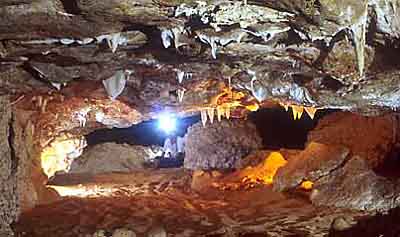 |
| And now it's back out into the
50-degree Centigrade heat!
|
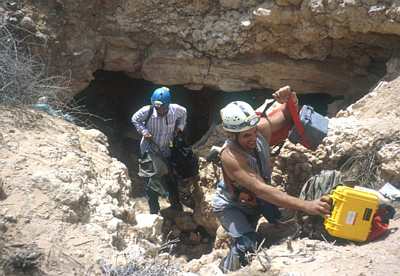 |
You
might imagine from my comments that only a Turkish midget would feel at
home in
a cave like this, but in reality, it’s quite a fascinating place and
ought to
appeal to adventurous souls. You'll find this one on our list of Caves
with
Potential for Ecotourism.
John Pint